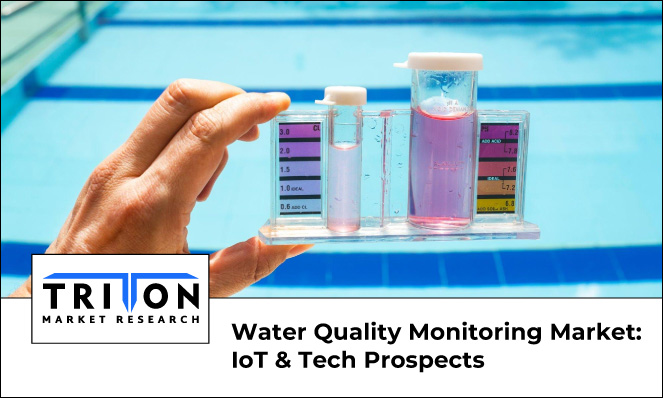



08, February 2023

With the rising population, climate crisis, and increasing pollution levels, ensuring the availability of safe water has become a major concern. Routine assessment of water quality is thus crucial, and water quality monitoring (WQM) systems have been immensely beneficial in this regard. As a result, their adoption has significantly increased in recent years, driving the growth of the global water quality monitoring market.
Experts at Triton Market Research estimate this market to grow with a CAGR of 5.51% in the forecast years between 2023 and 2030, reaching a revenue of $8275.72 million by 2030. Earlier, monitoring was conducted using manual, costly, and time-consuming laboratory-based testing techniques. However, the development of fully integrated and reliable WQM systems has largely optimized this process as they provide real-time data and insights. This has widened the market’s growth prospects worldwide.
Several governments in Europe have implemented stringent regulations to safeguard water bodies in the region. The increased emphasis on promoting sustainable water usage, preventing & reducing pollution, and protecting & improving the aquatic ecosystem has largely enhanced the adoption of water quality monitoring devices and systems across the European market.
Major players from the chemical, textile, beauty & cosmetics, and automotive industries are shifting their manufacturing and industrial facilities from developed nations to developing ones. With this, the carbon emission levels and industrial waste generation have also risen. Moreover, the regulations pertaining to wastewater disposal in these countries are not as stringent as those in developed economies.
The serious health issues caused by consuming contaminated water have necessitated the adoption of WQM systems. Thus, the studied market shows immense scope for expansion in the Asian, African, and Latin American regions. In fact, the Latin America water quality monitoring market is anticipated to progress with the fastest CAGR of 7.42% during the forecasted period.
One of the causes of waterborne diseases is the consumption of water that is highly acidic or alkaline in nature, as it can disrupt the body’s balance. Thus, measuring its pH levels is important. While this was traditionally done using pH indicators, sensor technology advancements have enabled more accurate assessment with the development of pH sensors.
pH sensors dominates the component segment. It held the highest revenue share of $1705.72 million in 2022, and is likely to grow with the fastest CAGR of 5.83% during 2023-2030.
Using its patented technology, Emerson Electric Co has developed the Rosemount 550 single-use pH sensor; it has a two-year shelf life, and is incorporated with immediate sensor verification and calibration features, which eliminates the need for initial stabilization. Besides, Xylem Inc and Thermo Fisher Scientific Inc are also renowned for their cutting-edge pH sensors and analyzers.
Product launches by market players, government regulations on water-intensive industries, and the damaging effects of acidic or basic water on pipelines & other equipment have surged the demand for these sensors. The above-mentioned factors, along with the high applicability of the sensors across various industries, contribute to the growth of the global pH sensors & analyzers market.
Even though the currently used wireless sensor network-based water monitoring systems have undergone technological advancements over the years, they come with their share of problems. However, the integration of the Internet of Things (IoT) in them has facilitated smart water quality monitoring, by ensuring greater efficiency, security, and cost-effectiveness, along with providing real-time data.
IoT allows smart devices to conveniently store and exchange data, and thus, this technology has found its applications in environmental monitoring. One of its benefits is that IoT-enabled WQM systems help treat wastewater before it is released into freshwater bodies.
Every year, millions of gallons of water are wasted due to leaks, meter errors, and other operational inefficiencies. IoT-based water flow sensors are useful for spotting leakages and other malfunctions immediately by analyzing the flow through pipes. This helps curb the problem before it results in high bills for commercial and residential end-users.
Realizing this growth opportunity, Scotland-based M2M Cloud is working towards enhancing its existing Neptune water monitoring device’s capabilities by incorporating IoT, as part of a $156,247 project, in association with CENSIS. This is indicative of the fact that tech integration and innovation are key for players to sustain and thrive in the water quality monitoring market.
The high cost of WQM systems majorly hinders their adoption, thus restricting the market growth.
Q 2) Which are the various applications studied in the market report?Industrial, Commercial, Utilities, Residential, and Other Applications are studied in the market report.
Q 3) Which region leads the global WQM market?With the highest revenue of $2220.46 million in 2022, North America leads the global market.

Prevalent cases of terrorist attacks in today’s world is increasing the need for severe standards of security for public safety, and the global market for biometric technology scrupulously accommoda..
Prevalent cases of terrorist attacks in today’s world is increasing the need for..